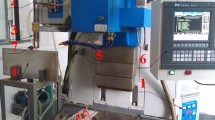Abstract
A high-frequency induction hardening analysis method was established based on electromagnetic-thermal translation analysis (cosimulation). The same conditions as those used in the experiment were applied to the high-frequency induction hardening analysis, using the temperature-dependent material properties of AISI 1045. Cooling parameters coincided with the cooling conditions of water in the analysis. The hardening depth of the high-frequency induction-hardened specimen was measured using a micro Vickers hardness tester, and the hardening depth and hardening pattern were verified in terms of the resulting metallurgical structure. Experimental results were compared with those obtained from finite element analysis (FEA) simulations. The hardening pattern was confirmed with AISI 1045 heating to temperatures above 746°C, corresponding to the A2 transformation point, and then cooling to below 200°C. There was good agreement between experimental and FEA results for the heating and cooling temperatures, as well as the hardening depth and hardened area. When AISI 1045 was heated above the A2 transformation point, its structure transformed from ferrite to austenite; thus, it changed from a magnetic material to a non-magnetic material. FEA of the magnetic flux density and Joule heat density during the heating period revealed that high-frequency induction hardening is favorable for surface hardening.
Similar content being viewed by others
References
Thelning, K. E., “Steel and Its Heat Treatment,” Elsevier, 1984.
Guterres, N. F. D. S., Rusnaldy, and Widodo, A., “The Effect of Temperature in Induction Surface Hardening on the Distortion of Gear,” Proc. of IOP Conference Series: Materials Science and Engineering, Paper No. 012092, 2017.
Lee, I. Y., Tak, S. M., Pack, I. S., and Lee, S. S., “Comparative Study on Numerical Analysis using Co-Simulation and Experimental Results for High Frequency Induction Heating on SCM440 Round Bar,” Journal of Aerospace System Engineering, Vol. 11, No. 3, pp. 1–7, 2017.
Oh, D. W., Kim, T. H., Do, K. H., Pack, J. M., and Lee, J. H., “Design and Sensitivity Analysis of Design Factors for Induction Heating System,” Journal of the Korean Society for Heat Treatment, Vol. 26, No. 5, pp. 233–240, 2013.
Ji, H. C., Wang, B., and Fu, X. B., “Study on the Induction Heating of the Work Piece before Gear Rolling Process,” Proc. of AIP Conference, Paper No. 120010, 2017.
Choi, J.-K., Park, K.-S., and Lee, S.-S., “Predicting the Hardening Depth of a Sprocket by Finite Element Analysis and Its Experimental Validation for an Induction Hardening Process,” Journal of Mechanical Science and Technology, Vol. 32, No. 3, pp. 1235–1241, 2018.
Chen, S. C., Peng, H. S., Chang, J. A., and Jong, W. R., “Simulations and Verifications of Induction Heating on a Mold Plate,” International Communications in Heat and Mass Transfer, Vol. 7, No. 31, pp. 971–980, 2004.
Eom, H. and Park, K., “Fully-Coupled Numerical Analysis of High-Frequency Induction Heating for Thin-Wall Injection Molding,” Polymer-Plastics Technology and Engineering, Vol. 48, No. 10, pp. 1070–1077, 2009.
Park, K., Eom, H., and Ik Lee, S., “Fully-Integrated Numerical Analysis of Micro-Injection Molding with Localized Induction Heating,” AIP Conference Proceedings, pp. 192–197, 2010.
Dassault Systèmes, “Benchmarks Manual, 1.8 Electromagnetic Analysis,” 2017.
Dassault Systèmes, “Workshop 1. Induction Heating of a Cylindrical Rod,” 2016.
Tong, D., Gu, J., and Totten, G. E., “Numerical Simulation of Induction Hardening of a Cylindrical Part Based on Multi-Physics Coupling,” Modelling and Simulation in Materials Science and Engineering, Vol. 25, No. 3, Pape No. 035009, 2017.
Kurganov, V. A., “Heat Transfer Coefficient,” Thermopedia, 2011. (DOI: 10.1615/AtoZ.h.heat_transfer_coefficient)
Chen, X., Xiao, N., Li, D., Li, G., and Sun, G., “The Finite Element Analysis of Austenite Decomposition during Continuous Cooling in 22MnB5 Steel,” Modelling and Simulation in Materials Science and Engineering, Vol. 22, No. 6, Paper No. 065005, 2014.
KS D 0027, “Methods of Measuring Case Depth for Steel Hardened by Flame or Induction Hardening Process,” 2002.
Hwang, J. J., Kwon, O. K., Yun, J. H., and Park, K., “Finite Element Analysis of Induction Heating Process for Development of Rapid Mold Heating System,” Transactions of Materials Processing, Vol. 16, No. 2, pp. 113–119, 2007.
Author information
Authors and Affiliations
Corresponding author
Additional information
Jin-Kyu Choi Jin-kyu Choi is currently studying his doctoral degree in School of Mechanical and Aerospace Engineering at Gyeongsang National University in Jinju, Republic of Korea. His research area includes induction heating and Structural analysis.
Kwan-Seok Park Kwan-seok Park is currently studying his doctoral degree in School of Mechanical and Aerospace Engineering at Gyeongsang National University in Jinju, Republic of Korea and is working in Daesung Total Heat Treatment. His field of research is induction heating.
Seok-Soon Lee Seok-soon Lee is working as a Professor in School of Mechanical and Aerospace Engineering at Gyeongsang National University in Jinju, Republic of Korea. He has been guiding many research scholars for many years. His research area includes finite element analysis, optimal design and also involved in numerous innovative researches. He completed his doctoral and graduate degree at KAIST, Republic of Korea.
Rights and permissions
About this article
Cite this article
Choi, JK., Park, KS. & Lee, SS. Prediction of High-Frequency Induction Hardening Depth of an AISI 1045 Specimen by Finite Element Analysis and Experiments. Int. J. Precis. Eng. Manuf. 19, 1821–1827 (2018). https://doi.org/10.1007/s12541-018-0210-0
Received:
Revised:
Accepted:
Published:
Issue Date:
DOI: https://doi.org/10.1007/s12541-018-0210-0




